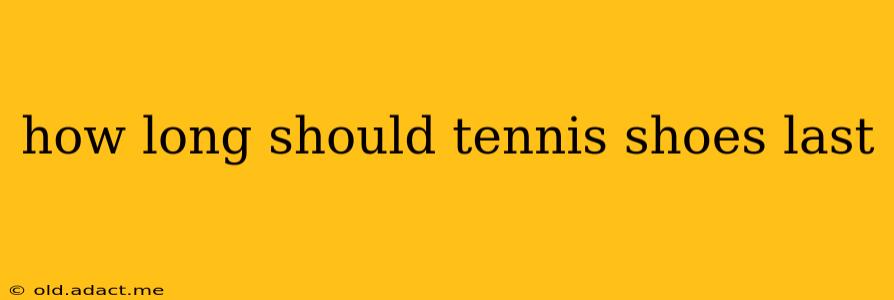Tennis shoes, whether for playing tennis or everyday wear, are a significant investment. Knowing how long they should last helps you maximize their use and avoid injuries. The lifespan of your tennis shoes, however, isn't a simple number. Several factors influence how quickly they wear down. This guide will explore these factors and help you determine when it's time to replace your trusty kicks.
How Many Months Should Tennis Shoes Last?
There's no magic number of months. A general rule of thumb is 3-6 months for serious athletes playing multiple times a week and 6-12 months for casual wearers. But this is just a starting point. The actual lifespan hinges on various factors.
What Factors Affect the Lifespan of Tennis Shoes?
Several factors drastically impact how long your tennis shoes last:
-
Frequency of Use: Daily use will naturally shorten the lifespan compared to occasional wear. The more you play or walk in them, the faster the wear and tear.
-
Intensity of Use: Playing intensely on hard courts puts significantly more stress on your shoes than casual walks. Aggressive playing styles accelerate wear and tear on the outsole and midsole.
-
Playing Surface: Hard courts are notoriously abrasive, causing quicker wear compared to softer surfaces like clay or grass.
-
Shoe Quality: Higher-quality shoes, using superior materials and construction, generally last longer than cheaper alternatives. Investing in durable shoes can save you money in the long run.
-
Proper Fit: Shoes that are too tight or too loose can lead to uneven wear and tear, reducing their overall lifespan. A proper fit ensures even pressure distribution.
-
Maintenance: Proper care and cleaning can prolong the life of your tennis shoes. Regularly cleaning dirt and debris prevents premature wear.
How Can I Tell When My Tennis Shoes Need Replacing?
Several signs indicate it's time for a new pair:
-
Visible Wear and Tear: Examine the outsole for significant wear. Thinning, bald spots, or visible grooves are clear indicators. Check the midsole for compression or damage.
-
Loss of Cushioning: If the shoes no longer provide adequate cushioning, your joints will bear the brunt of the impact, increasing your risk of injury. This is often harder to notice until it's a serious problem.
-
Loss of Support: Noticeable sagging or instability in the shoes suggests a loss of support, leading to potential ankle or foot injuries.
-
Discomfort: Persistent aches, pains, or discomfort during or after activity suggests your shoes aren't providing proper support anymore. Don't ignore persistent pain.
-
Sole Separation: If the outsole is separating from the midsole, it's a critical sign that your shoes are failing structurally and need immediate replacement.
How Often Should I Replace My Running Shoes if I Play Tennis?
While tennis shoes and running shoes serve different purposes, similar wear and tear factors apply. The lifespan of running shoes used for tennis will depend on the factors discussed above (frequency, intensity, surface, etc.). However, running shoes are generally not designed for the lateral movement and quick changes in direction inherent in tennis. Using running shoes for tennis may lead to increased risk of injury and quicker wear.
How Can I Extend the Life of My Tennis Shoes?
-
Rotate Your Shoes: Having multiple pairs allows you to alternate use, preventing excessive wear on any single pair.
-
Clean Your Shoes Regularly: Remove dirt and debris after each use to prevent buildup and abrasion.
-
Store Properly: Store your shoes in a cool, dry place to prevent premature deterioration.
-
Use Shoe Trees: Shoe trees help maintain the shape and structure of your shoes, preventing warping and premature wear.
Conclusion: Prioritize Your Health and Performance
Ultimately, the lifespan of your tennis shoes depends on individual factors. Prioritize your foot health and performance. Don't wait until your shoes are completely worn out before replacing them. Regularly inspect your shoes and replace them when necessary to protect yourself from injuries and maximize your performance on the court.
